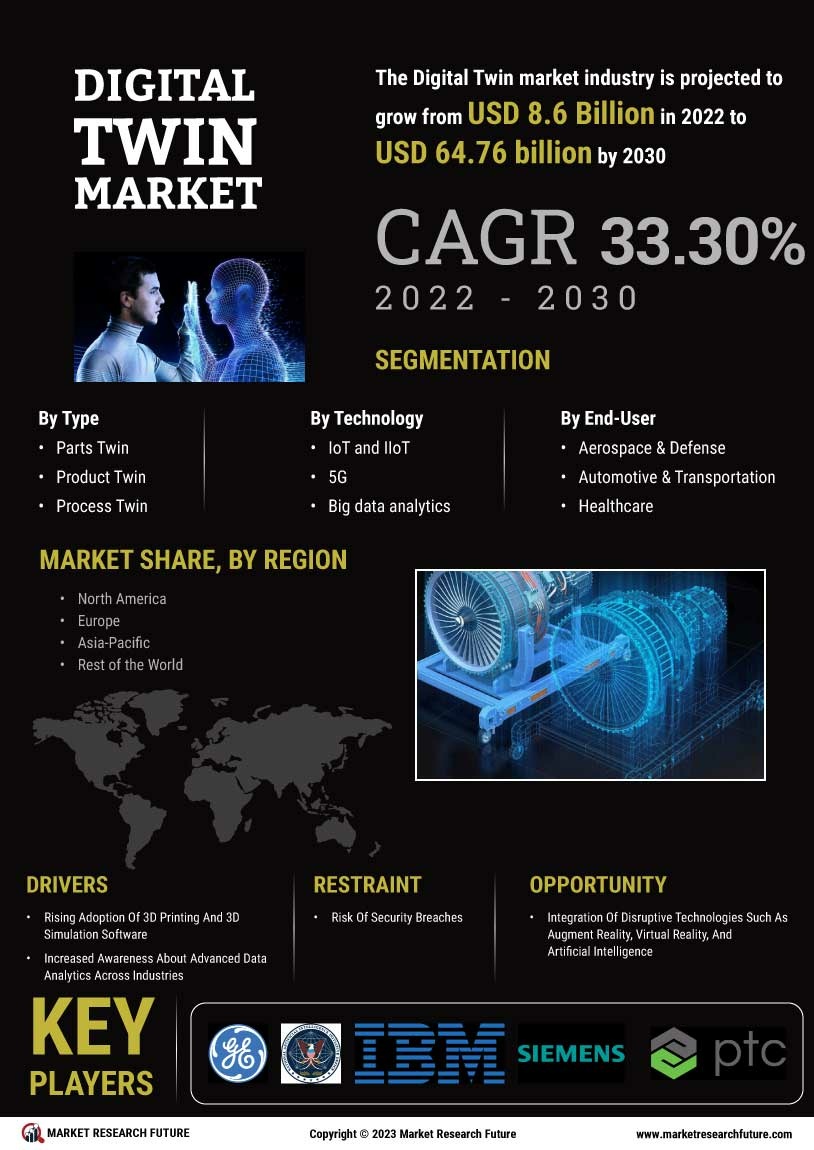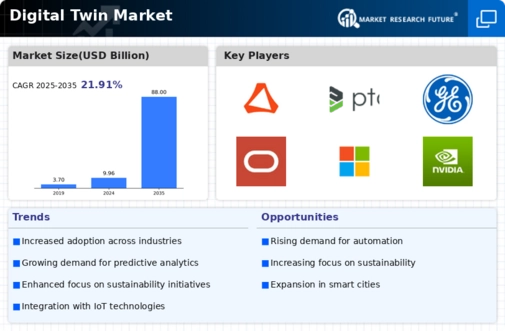Kindly complete the form below to receive a free sample of this Report

デジタルツインマーケットの概要
デジタルツイン市場は、2030年までに33.31%のCAGRで成長する632.3億米ドルに達すると予想されています。2020年にCOVID19のパンデミックが発生し、現在の状況と市場動向を分析して市場予測が行われました。
信頼性の高いテクノロジーという形でのデジタルツインは、特に医療、ヘルスケアサービス、製薬セクターなどの垂直市場で、急増する需要を目の当たりにしています。新しいコロナウイルスの致命的な到着と感染率において、特にさまざまなヘルスケアサービスやサービスプロバイダーの需要を促進している主な理由。しかし、市場が成長し、日常の技術要件に追いつくためには、市場は上昇するトレンドとテクノロジーに追いつくために絶え間ないアップグレードとメンテナンスが必要です。
デジタルツインマーケットCOVID 19分析:
世界的な市場運営は、経済能力と一般的な需要の大幅な低下に直面しています2019年後半にパンデミックが到来して以来、2020年に続きました。ほとんどの石油生産会社は、抽出された石油の保管スペースが不足しており、その需要は減少しています。その結果、需要と供給の間に大きなギャップが生じ、市場の均衡が崩れています。航空宇宙、防衛、自動車、輸送、エネルギー、電力など、あらゆる経済のバックボーンである主要産業は、パンデミックのために主要な機能的および需要の問題に直面しています。厳格な対外貿易規制があり、国境の閉鎖はグローバルな事業に影響を与える可能性があります。
しかし、政府の焦点は、サービスのデジタル化と質の高いサービスを提供するための医療インフラの開発にあります。産業サービスのデジタル化は、コロナウイルスのパンデミック後に増加すると予想されています。また、2021-2028年の予測期間中、エネルギーおよび電力セクターの業界も増加しています。
デジタルツインマーケットのダイナミクス:
ドライバー:2020年のパンデミック発生以来、ヘルスケアセクターは大きな需要を受けています。デジタルツインは、患者の健康、錠剤の使用と影響を監視する上で重要な役割を果たし、他の要因も含まれています。また、市場のプレーヤーは、感染している人や症候群にかかっている人を特定するのに役立つデジタルツインマーケットソリューションの開発に力を入れています。また、感染した個人と接触した人の中から、抗体を開発した回復した患者を検出するのに役立ちます。このようなソリューションの使用と実装は、地方政府と州政府の両方がレッドゾーンとグリーンゾーンの両方を簡単に監視できるようにします。これらのソリューションは、世界規模でのスマートシティの開発と開始に役立ちます。
制約:
人工知能、IoT、詰まり、ビッグデータなどのデジタルテクノロジーの幅広い実装がビジネスユニット全体で増加しています。市場ソリューションは、フィジカルツインの仮想化に役立つIoTセンサーとテクノロジーの統合に役立ちます。接続性は拡大しており、セキュリティ、データ保護、規制、コンプライアンスなどの関連するリスクも増加しています。
テクノロジー分析:
パンデミック後、業界の製造業者は、さまざまな企業の境界、部門、市場の均衡を維持し、需要と供給の市場力の適切な管理を維持するためのユニット。デジタルツインテクノロジーは、同じことを始めるのに役立ちます。提供されるサービスは、市場運営を支援し、強力なデジタルショーとして機能します。これらは、資産のライフサイクルから相互に関連するすべてのデータソースを収集し、コンポーネント、人、アセンブリ、および製造プラント全体の双子を作成するのに役立ちます。これらは、機能を拡張し、市場の柔軟性を高め、ビジネスの失敗に関連するリスクを軽減するのに役立ちます。
- 市場の予測数値と、市場運営に影響を与える要因や制約などの要因と市場のダイナミクスを調査する
- 浸透しているさまざまなグローバル地域で機能している市場セグメントが続く傾向と戦略に注目して、市場の潜在的な収益を分析する
- 市場参加者の最近の動向を目の当たりにして、市場の範囲とその未来的なアプローチを理解すること。さらに、市場関係者の間で競争力のあるグラフを作成し、投資家がより適切で未来的な投資決定を下すのを支援する
デジタルツイン市場セグメントの概要:デジタルツイン市場予測は、市場セグメンテーションに基づく予測であり、以下に:
テクノロジー:
市場のテクノロジーセグメントには、IoTとIIoT、5G、ビッグデータ分析、ブロックチェーン、人工知能、機械学習、拡張現実、バーチャルリアリティ、複合現実が含まれます。
タイプ:
グローバル市場のタイプセグメントに基づいて、製品デジタルツイン、システムデジタルツイン、およびプロセスデジタルツインの取引が行われます。
デジタルツイン市場の地域分析:
デジタルツイン市場の動向は、APAC地域でより一般的であり、さらに次のように分類されています。インド、日本、中国などの地域と、その地域に属する他の地域。アジア太平洋地域は、主に機能している製造業の間でデジタルトランスフォーメーションを生み出す可能性が非常に高い市場であるため、2021年から2028年の予測期間中にCAGRが最も高いと予想しています。市場参加者の人口は増加しており、一人当たりの所得の増加に支えられて雇用機会がさらに増加しています。大規模な都市化と工業化は、IoTサービスの大規模な適応性の向上を目の当たりにしており、したがって、2021-2028年の予測期間中のAPAC地域における市場開発の拡大の目的に応えます。調査によると、中国の消費者は大きな景気回復を期待しているため、市場のプレーヤーは2028年に終了する進行中の予測期間中に拡大する可能性が高いことが示されました。
デジタルツインマーケットの競争状況:市場の競争グラフは、著名な市場プレーヤーのパフォーマンスに基づいています。市場の市場プレーヤーは次のとおりです。
- ゼネラル・エレクトリック (
- AI (米国)
- IBM (米国)
- シーメンスAG (ドイツ)
- PTC (米国)
- マイクロソフトコーポレーション (米国)
- ANSYS (米国)
- オラクル (米国)
- SAP (ドイツ)
Customer Stories

“This is really good guys. Excellent work on a tight deadline. I will continue to use you going forward and recommend you to others. Nice job”

“Thanks. It’s been a pleasure working with you, please use me as reference with any other Intel employees.”

“Thanks for sending the report it gives us a good global view of the Betaïne market.”

“Thank you, this will be very helpful for OQS.”

“We found the report very insightful! we found your research firm very helpful. I'm sending this email to secure our future business.”

“I am very pleased with how market segments have been defined in a relevant way for my purposes (such as "Portable Freezers & refrigerators" and "last-mile"). In general the report is well structured. Thanks very much for your efforts.”

“I have been reading the first document or the study, ,the Global HVAC and FP market report 2021 till 2026. Must say, good info! I have not gone in depth at all parts, but got a good indication of the data inside!”

“We got the report in time, we really thank you for your support in this process. I also thank to all of your team as they did a great job.”

